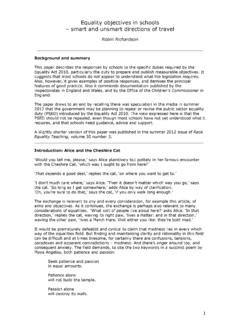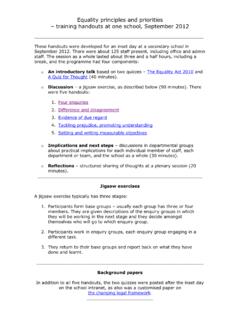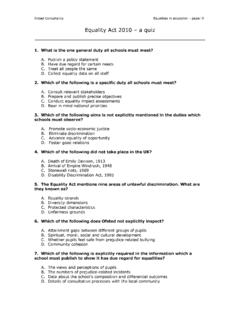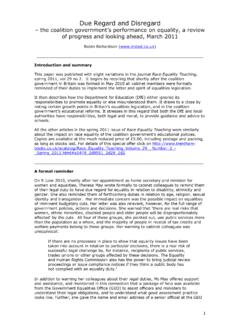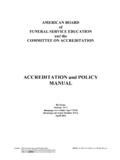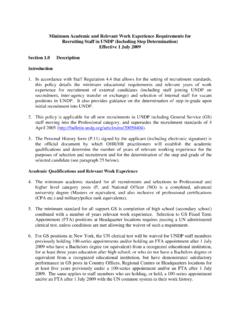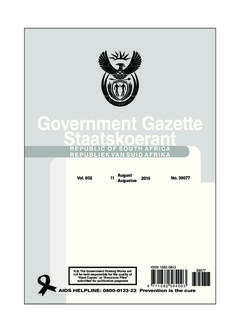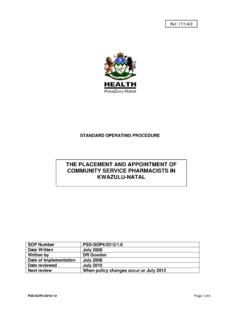Transcription of A model school policy statement - Insted
1 1 Insted Consultancy Equalities in education paper 1 A model school policy statement _____ Introductory notes Since the Equality Act 2010 came into effect in April 2011 there has no longer been a requirement that schools should draw up and publish equality schemes or policies. It is still good practice, however, for a school to make a statement about the principles according to which it reviews the impact on equalities of its policies and practices, and according to which it fulfils the specific duties to publish information and evidence, and to decide on specific and measurable objectives. This model statement has been adapted slightly from one which was developed in the period 2007 08, and first published in 2009. It has been modified in the light of the Equality Act 2010, and of the general and specific duties that the Act entails.
2 There is fuller information about the background in notes at the end. _____ Legal framework 1. We welcome our duties under the Equality Act 2010 to eliminate discrimination, advance equality of opportunity and foster good relations in relation to age (as appropriate), disability, ethnicity, gender (including issues of transgender, and of maternity and pregnancy), religion and belief, and sexual identity. 2. We welcome our duty under the Education and Inspections Act 2006 to promote community cohesion. 3. We recognise that these duties reflect international human rights standards as expressed in the UN Convention on the Rights of the Child, the UN Convention on the Rights of People with Disabilities, and the Human Rights Act 1998. Guiding principles 4. In fulfilling the legal obligations cited above, we are guided by nine principles: Principle 1: All learners are of equal value.
3 We see all learners and potential learners, and their parents and carers, as of equal value: o whether or not they are disabled o whatever their ethnicity, culture, national origin or national status o whatever their gender and gender identity o whatever their religious or non-religious affiliation or faith background o whatever their sexual identity. Principle 2: We recognise and respect difference. Treating people equally (Principle 1 above) does not necessarily involve treating them all the same. Our policies, procedures and activities must not discriminate but must nevertheless take account of differences of life-experience, outlook and background, and in the kinds of barrier and disadvantage which people may face, in relation to: 2o disability, so that reasonable adjustments are made o ethnicity, so that different cultural backgrounds and experiences of prejudice are recognised o gender, so that the different needs and experiences of girls and boys, and women and men, are recognised o religion, belief or faith background o sexual identity.
4 Principle 3: We foster positive attitudes and relationships, and a shared sense of cohesion and belonging. We intend that our policies, procedures and activities should promote: o positive attitudes towards disabled people, good relations between disabled and non-disabled people, and an absence of harassment of disabled people o positive interaction, good relations and dialogue between groups and communities different from each other in terms of ethnicity, culture, religious affiliation, national origin or national status, and an absence of prejudice-related bullying and incidents o mutual respect and good relations between boys and girls, and women and men, and an absence of sexual and homophobic harassment. Principle 4: We observe good equalities practice in staff recruitment, retention and development. We ensure that policies and procedures should benefit all employees and potential employees, for example in recruitment and promotion, and in continuing professional development: o whatever their age o whether or not they are disabled o whatever their ethnicity, culture, religious affiliation, national origin or national status o whatever their gender and sexual identity, and with full respect for legal rights relating to pregnancy and maternity.
5 Principle 5: We aim to reduce and remove inequalities and barriers that already exist. In addition to avoiding or minimising possible negative impacts of our policies, we take opportunities to maximise positive impacts by reducing and removing inequalities and barriers that may already exist between: o disabled and non-disabled people o people of different ethnic, cultural and religious backgrounds o girls and boys, women and men. 3 Principle 6: We consult and involve widely. We engage with a range of groups and individuals to ensure that those who are affected by a policy or activity are consulted and involved in the design of new policies, and in the review of existing ones. We consult and involve: o disabled people as well as non-disabled o people from a range of ethnic, cultural and religious backgrounds o both women and men, and both girls and boys.
6 O gay people as well as straight. Principle 7: Society as a whole should benefit. We intend that our policies and activities should benefit society as a whole, both locally and nationally, by fostering greater social cohesion, and greater participation in public life of: o disabled people as well as non-disabled o people of a wide range of ethnic, cultural and religious backgrounds o both women and men, and both girls and boys o gay people as well as straight. Principle 8: We base our policies and practices on sound evidence. We maintain and publish quantitative and qualitative information which shows our compliance with the public sector equality duty (PSED) set out in clause 149 of the Equality Act 2010, and on the basis of which we decide on specific and measurable objectives. Evidence relating to equalities is integrated into our self-evaluation documentation.
7 Principle 9: Measurable objectives We formulate and publish specific and measurable objectives, based on the consultations we have conducted (principle 6) and the evidence we have collected and published (principle 8). The objectives which we identify take into account national and local priorities and issues, as appropriate. Our equality objectives are integrated into the school improvement plan. We keep our equality objectives under review and report annually on progress towards achieving them. The curriculum 5. We keep each curriculum subject or area under review in order to ensure that teaching and learning reflect the principles set out in paragraph 4 above. Ethos and organisation 6. We ensure the principles listed in paragraph 4 above apply to the full range of our policies and practices, including those that are concerned with: 4o pupils' progress, attainment and achievement o pupils' personal development, welfare and well-being o teaching styles and strategies o admissions and attendance o staff recruitment, retention and professional development o care, guidance and support o behaviour, discipline and exclusions o working in partnership with parents, carers and guardians o working with the wider community.
8 Addressing prejudice and prejudice-related bullying 7. The school is opposed to all forms of prejudice which stand in the way of fulfilling the legal duties referred to in paragraphs 1 3: o prejudices around disability and special educational needs o prejudices around racism and xenophobia, including those that are directed towards religious groups and communities, for example antisemitism and Islamophobia, and those that are directed against Travellers, migrants, refugees and people seeking asylum o prejudices reflecting sexism and homophobia. 8. There is guidance in the staff handbook on how prejudice-related incidents should be identified, assessed, recorded and dealt with. 9. We keep a record of prejudice-related incidents and, if requested, provide a report to the local authority about the numbers, types and seriousness of prejudice-related incidents at our school and how they are dealt with.
9 Roles and responsibilities 10. The governing body is responsible for ensuring that the school complies with legislation, and that this policy and its related procedures and action plans are implemented. 11. A member of the governing body has a watching brief regarding the implementation of this policy . 12. The headteacher is responsible for implementing the policy ; for ensuring that all staff are aware of their responsibilities and are given appropriate training and support; and for taking appropriate action in any cases of unlawful discrimination. 13. A senior member of staff has day-to-day responsibility for co-ordinating implementation of the policy . 14. All staff are expected to: o promote an inclusive and collaborative ethos in their classroom o deal with any prejudice-related incidents that may occur o plan and deliver curricula and lessons that reflect the principles in paragraph 4 above 5o support pupils in their class for whom English is an additional language o keep up-to-date with equalities legislation relevant to their work.
10 Information and resources 15. We ensure that the content of this policy is known to all staff and governors and, as appropriate, to all pupils and their parents and carers. 16. All staff and governors have access to a selection of resources which discuss and explain concepts of equality, diversity and community cohesion in appropriate detail. Religious observance 17. We respect the religious beliefs and practice of all staff, pupils and parents, and comply with reasonable requests relating to religious observance and practice. Staff development and training 18. We ensure that all staff, including support and administrative staff, receive appropriate training and opportunities for professional development, both as individuals and as groups or teams. Breaches of the policy 19. Breaches of this policy will be dealt with in the same ways that breaches of other school policies are dealt with, as determined by the headteacher and governing body.
